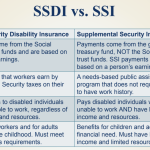After many years of extensive experience as Social Security Disability (SSD or SSDI) lawyers, specializing in helping disabled residents of Northern Indiana and the Chicago metro area, we know that many new clients have similar questions. At Scully Disability Law Office, we want every client to fully understand their own SSD benefits and how they may change when their life circumstances change.
Your SSD Benefits Are Equal to Your Social Security Retirement Benefit
As we will explain in this article, the amount of your SSD benefit payment and your Social Security Retirement (Retirement) benefit payment at your Full Retirement Age (FRA) is the same. However, if you file for retirement benefits before you reach your FRA and then begin to receive SSD benefits, then your monthly benefit payment will be lowered when you reach your full retirement age. (Your Full Retirement Age is explained below.)
SSD Benefits and Social Security Retirement Benefits Determined by the Same Formula
The Social Security Administration uses the same formula and calculations to determine the amount of your SSD benefits and your Retirement benefits. Both programs are based on your average annual lifetime taxable income. The government takes your 35 highest earning years and uses an indexing system to adjust your average annual income for inflation. That produces your Average Indexed Monthly Income (AIME).
The government then takes your AIME applies the following formula:
2021 Monthly Benefit Formula for SSD and Soc. Sec. Retirement:
- 90% from the first $996, plus
- 32% from earnings over $996 but under $6,002, plus
- 15% of monthly earnings over $6,002
2022 Monthly Benefit Formula for SSD and Soc. Sec. Retirement
- 90% from the first $1,024, plus
- 32% from earnings over $1,025 but under $4,643 plus
- 15% of monthly earnings over $4,643.
Social Security Disability Benefits Before Age 65
It’s important to remember that SSD benefits are exclusively designed to provide financial support to disabled workers who paid into the Social Security System through payroll deductions or self-employment taxes. To qualify for SSD benefits, workers need to have worked long enough to earn a minimum number of “work credits.”
At Thomas J. Scully, III and Associates Scully Disability Law, we are expert SSD attorneys who devoted our entire professional career to fighting exclusively to get disabled and needy people all the SSD and SSI benefits they deserve. Social Security Disability law practice requires years of study and experience to master the many government rules and regulations. We are here to make sure you get the maximum possible SSD benefits you earned through years of hard work.
To be eligible for SSDI benefits, you need to be able to demonstrate that you are suffering from a “medically determinable physical or mental impairment that prevents you from performing substantial gainful activities” for at least 12 months or is expected to result in death. Only people who are of working age can qualify to receive SSD benefits.
Full Retirement Age Is Not 65 Anymore
Only people born in or before 1937 reached Full Retirement Age (FRA) when they turned 65. Since anyone born in 1937 would now be 84 years old, no one currently receiving SSD benefits will reach their full retirement age at 65.
The Social Security Administration implemented a new system setting gradually increasing workers’ full retirement age from 65 to age 67. Starting with people who were born in 1938, people born in each successive year reach their full retirement at ages other than their 65th birthday. The full retirement age for anyone born in 1960 or later is 67 years old.
For example, if you were born in 1958, then your full retirement age is 66 and 8 months. Here is a chart to help you determine your full retirement age:

Early Retirement Followed by SSD Benefits Application
You can file for Social Security Retirement benefits as early as age 62. But those who do file early lose a percentage of their Full Retirement Age benefit.
Let’s assume you file for retirement benefits at age 62. Your monthly Retirement benefit would be 70% of your full retirement benefit. If you then became disabled and qualified for SSD benefits, you would receive monthly SSD benefits that are equal to your full retirement benefits. You would continue to receive those SSD benefits until you reached your Full Retirement Age. At that time, your Retirement benefits would return to the 70% level because you filed for Retirement benefits at age 62 and permanently surrendered a claim for your full Retirement benefit.



